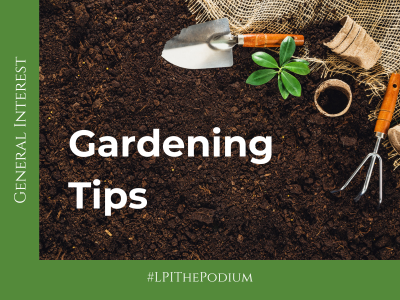
Now that we are starting to move into warmer weather and the rainy season is on its way out, this is a great time to spruce up your garden or start planning for one. Here are some great tips to help you have a beautiful, fuss-free garden.
Mid-Spring
- Clean bird feeders. Some people like to take down their bird feeders in spring and store them away until fall. If you want to leave them up year-round, now’s a good time to empty and wash them out. Then fill your feeders with fresh seed.
- Make notes as you watch the spring show. Some of your spring bulbs should be starting to flower. Enjoy the blooms and take note of any empty spots where you’ll want to plant bulbs later in the fall.
- Plant new perennials and cold-hardy annuals. Freshly planted perennials need a little time to get settled and grow new roots before hot summer weather hits. For some quick garden color, add a few cool-season annuals, like pansies or snapdragons. They also work well in containers, where they’ll brighten your front porch.
- Add new trees and shrubs. Plant as soon as the ground is no longer frozen. The earlier you can do this, the better, so your trees and shrubs have enough time to grow new roots before temperatures start getting hot.
- Apply fresh mulch. Once you’re finished planting, add a fresh layer of mulch around all your new plants. If you mulch now, before weeds have a chance to sprout, you’ll have next-to-no weeding come summer.
Late Spring
- Deadhead flowering bulbs. Remove spent blossoms from spring-flowering bulbs; this encourages the plants to store energy for next year rather than expend it to make seeds. Let the foliage die back on its own, and don’t remove it until it’s completely yellow or dried up.
- Shop for summer annuals. Pick out flats of your favorite summer annuals, like petunias, impatiens, and zinnias. Choose plants that aren’t yet in bloom, because they’ll be stronger.
- Start warm-season vegetables. While you’re harvesting the radishes and lettuces you sowed early in the spring, you can transplant seedlings of warm-season crops, like tomatoes, peppers, and all sorts of herbs.
- Plant summer-blooming bulbs. While spring-blooming bulbs should be planted in the fall, summer-blooming bulbs, like dahlias and gladiolus, should be planted once there’s no more threat of frost. Check your area’s average last frost date for a general idea of when to plant these bulbs, then get them in the ground once the soil has warmed up.
Use this spring gardening checklist and you’ll have one of the best-looking yards on the block. While there are still a few maintenance chores you should do every season, once you power through these spring tasks early in the growing season, you’ll have more time to kick back and enjoy your landscape throughout the summer.
Credit: Better Homes & Gardens, January 2024.
Categorized in: General
| << previous | next >> |








